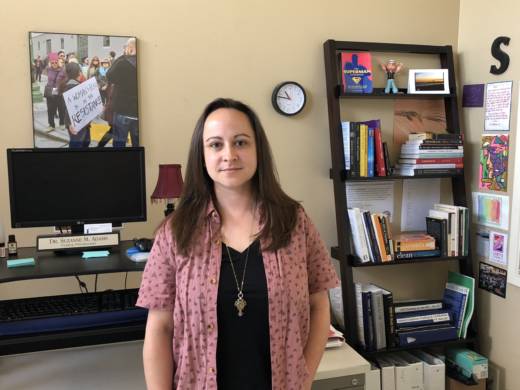"She wasn’t leaving the building under her own accord," Adams said. "She wasn’t accessing food or water without the assistance of other people. She tried to pay me a dollar the other day to go buy her some ramen so that she could eat."
Adams sent the woman to the hospital, hoping psychiatric services would help.
"Unfortunately, less than 24 hours later, she returned here," Adams said.
The same client was resting at the center on the day a KQED reporter visited, sitting in a black chair that she favors. Adams said the woman’s mental illness still wasn't well-controlled, so she couldn't speak coherently or consent to an interview.
"In an ideal world, she would be transferred to a 'board and care' or an assisted living facility, where they could manage her mental health as well as her medical health in a fashion that we simply don’t have the infrastructure for," Adams said.
The legislation moving through the state Senate would require that patients be discharged to one of four "safe and appropriate" locations: their primary dwelling (as identified by the homeless patient), another health center or hospital, a nonprofit or social service agency that has given written consent to accept the patient, or an alternative spot that the patient has consented to go to, in writing.
Sen. Ed Hernandez, D-West Covina, introduced the bill. He said hospitals, as part of society, have obligations to homeless Californians.
"If they fall down and have a heart attack, and somebody sends them to the hospital, we’re required by law -- which is the humane thing to do -- to treat those individuals," said Hernandez, who is an optometrist and chair of the Senate Health Committee. He was referring to a federal law called EMTALA, which mandates that emergency rooms accept and treat everyone, regardless of ability to pay.
But EMTALA doesn't address how patients are discharged from ERs. "Once they’re treated, the humane thing is to figure out where we’re going to place them, as opposed to just leaving them out in the street immediately," Hernandez said.
His bill would require some additional work on the part of ER staffers at California hospitals, such as getting consent from a shelter where the hospital wants to send the patient.
"I can’t imagine that it’s going to be that costly to pick up the phone," Hernandez said.
The legislation also lays out a checklist of things to do before discharge. For example, the patient must be hydrated, have recently eaten and be dressed in weather-appropriate clothing.
But hospitals are pushing back, saying the list is too specific, and doesn’t give hospital workers enough flexibility to decide what’s right for each patient.
Peggy Wheeler is the vice president for rural health and governance for the California Hospital Association. She said the bill would put yet another burden on emergency care.
"Hospital ERs are overcrowded," Wheeler said. "If we had to hold on to a patient in a bed in the ER, that’s one less bed, two less beds, three less beds that would be available for other members of the community that need to come in and use the ER."
Adams, the psychologist at A Woman’s Place, thinks the bill is a good step. But she said it doesn’t get at the root problem, which is that the Bay Area doesn’t have enough options for patients who still need help after they leave the hospital. There aren’t enough nursing homes, rehabilitation units or assisted care programs for elderly, low-income or disabled patients.
"It’s a health insurance issue, it’s an aging issue, it’s a lack of infrastructure and funding," Adams said.
Until that gets fixed, Adams fears many patients will continue to shuttle between hospitals, the shelter system and the street.
